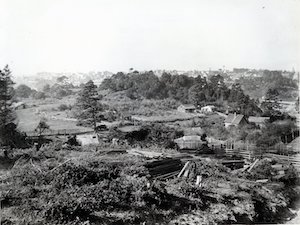
View looking northwest of cultivated fields and rural houses south of Big River, taken c. 1900 by A. O. Carpenter, according to a note on the back of the photo. The town of Mendocino is in the background. In the foreground a pile of sawn boards lies on the ground. Fields are enclosed with a variety of fencing materials, including vertical split pickets, horizontal split rails, and boards.
The house with the chimney on the right is the Martin Ferdinand Schultz House. Schultz purchased this property for $60 from Peter Gustavus Palmstream in 1879 (Mendocino Beacon 9 Jul 1879, p. 3). When Schultz died in 1908, John Peterson, the accomplished Big River millwright, bought the house so that he could be near his beloved work place across the river. Over several years Peterson substantially rebuilt the property, adding extensive flower, fruit, and vegetable gardens that he tended in his retirement, according to newspaper reports and family letters.
The Coast Road traverses the area from left to right and begins its descent down a former stream bed to the low bridge crossing Big River. Note the utility poles along the edge of the road, which at this time probably carried telegraph and telephone service, and not electrical wires. Another road intersects with it and is partially seen between the fence lines as it leads eastward toward Comptche and Ukiah. Small deciduous trees, possibly fruit trees, are visible behind fences on the right side of the image.
Several buildings occupy the land on the other side of the Coast Road. A large shed sits within a field, and nearby is a small gable-roofed structure with vertical siding. A barn-like structure and a smaller white dwelling occupy the hillside above the road. Right of the house is a small fenced orchard with two rows of trees. It is possible that these are improvements remaining from the time period related to the Chinese Gardens (China Garden), which occupied a site on the west side of the Coast Road and south of Big River, according to lease documents. For some years it was cultivated by Chinese immigrants and supplied vegetables to people in the Mendocino area.
When the gardens actually began is not known, but the area they occupied was the property of the State of California until 1871, when Peter G. Palmstream received the patent to own this land. The U. S. Coast & Geodetic survey published in 1873 shows the same arrangement of structures and fences as this photo (a barn and a dwelling with a small fenced area on its north side), indicating that farming activities in this area occurred prior to 1873.
Ah Sow and Ah Sam leased the property in 1887 from Christina Palmstream, the widow of Peter G. Palmstream, for a lease term of two years.
It is possible the Chinese Gardens ended a year later in 1888 when Ah Sow sold his lease and all the farming equipment to Henri Rohlicek, an Austrian brick maker who lived two miles up the Ukiah Road. At the time of the leasehold sale, William Heeser owned the property. Auggie Heeser, his son, sold it in 1929 to William P. and Alice Stanton of San Francisco, who built a summer home and boathouse there.
In 1960, China Hill, as it was known, was divided down the middle from north to south by the realignment of Highway 1. The large volume of dirt excavated from the massive cut was trucked across the river and placed on the river flat to create the northern approach to the new, high bridge over Big River.
Look Tin Eli: The Mendocino Visionary Who Helped Shape the Chinese-American Experience by Robert S. Becker and Jane Tillis – The life of Mendocino-born visionary Look Tin Eli was one of national significance. As a teenager returning home from China in 1884, his illegal detention instigated a court battle, culminating in the state’s legal precedent granting full citizenship for all native-born Californians. After the 1906 earthquake in San Francisco, he was instrumental in establishing Chinatown as a business center and tourist destination. He founded the first Chinese-owned bank, the Canton Bank of San Francisco, and he started the China Mail steamship company. With almost fifty historic images, this first book-length profile of Look Tin Eli brings to life the cultural and commercial achievements of this remarkable trailblazer. $25.